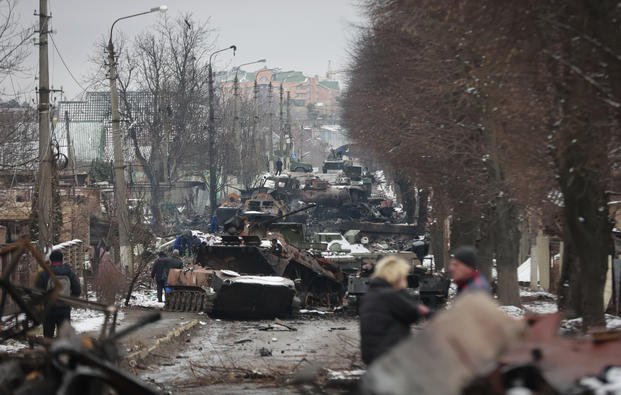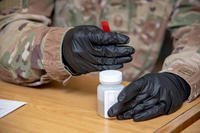The opinions expressed in this op-ed are those of the author and do not necessarily reflect the views of Military.com. If you would like to submit your own commentary, please send your article to opinions@military.com for consideration.
Gary Anderson served in Mogadishu, Somalia, in 1993 and directed several urban war games in 1994-95. He served as chief of staff for the Marine Corps Warfighting Lab during the Urban Warrior experiments and later directed the follow-on Project Metropolis study as the director of the Marine Corps' Center for Emerging Threats and Opportunities.
Vladimir Putin's plan for a quick decapitation of Ukraine's government and swift capitulation of its major cities was the first casualty of his war. Now, the Russian military is faced with urban combat, something for which it is not prepared.
Russian combined-arms doctrine has generally advised against making cities primary objectives. The belief has been that if the enemy's main force in the field is destroyed, then his cities will surrender.
Although Russian special forces are probably given some instruction in urban combat, there is no indication that the average conscript has any training in the physical and psychological rigors of street fighting.
This leaves the Russians two options if major Ukrainian cities continue to resist. The first is a prolonged siege to starve the Ukrainians out; the second is to blast the cities into rubble. Those options are not mutually exclusive. Both can be used simultaneously, but both are ugly and will earn Russia the enmity of the rest of the world for years to come.
The Russians got away with leveling Grozny in the Chechen Republic in 1994 because the Chechen rebels were portrayed as vicious terrorists. Horrific events such as the Beslan school siege made it difficult to sympathize with those in charge of the Chechen revolt.
The Russian military wrote off its campaign against the Chechens as anomalistic and got on with business as usual. Americans drew a different lesson from our urban warfare experience in Somalia in 1993. During that conflict, we saw the use of willing human shields swarming over our troops and the skillful manipulation of propaganda to incite the urban population against U.S. and U.N. forces that had come into the country originally to help the very people that we were now fighting.
Beginning in 1994, the Marine Corps began serious efforts to examine the problems of urban combat in a modern, media-dominated environment. The long-term study began with war games. In 1998, Commandant Gen. Charles Krulak directed the Marine Corps Warfighting Lab to conduct a series of major urban experiments, dubbed Urban Warrior. The initial results were not encouraging. In one experiment in Oakland, California, the blue (American) force took 75% casualties.
As the lab's chief of staff, I told a Washington Post reporter that "we suck at this." But I was confident we would learn from the experience. As time went on, we developed several promising technological aids to assist in fighting in urban environments. These included small robots for disabling booby traps, scalable airborne munitions that could take out a room in a structure rather than destroying the whole building, and even protective clothing such as kneepads to make entrance through windows less hazardous. We also experimented with nonlethal weapons capable of incapacitating rather than killing when fighters used civilians as human shields. And every infantryman would eventually get a sniper scope.
However, the most revealing lessons learned were tactical. As in football, quantity does not have a quality of its own in urban warfare. You can put only so many players on the field at a time in an urban canyon. Urban combat is largely a squad leader's war, and the better-trained and better-led squad will usually win. This led us to develop two concepts that would eventually serve the Marine Corps well in Iraq and Afghanistan. Krulak dubbed them the "Three Block War" and the "Strategic Corporal."
The Three Block War refers to the possibility that a small unit may have to transition quickly from full-scale urban combat on one block to peacekeeping/police operations on another, and humanitarian operations on a third. In our experiments, we found that the mental transition from one situation to another needs to be near instantaneous and requires special leadership skills.
This leads to the concept of the Strategic Corporal. Most of our urban experiments were conducted in actual cities under intense media scrutiny. In the San Francisco Bay area, a significant portion of the population was suspicious -- if not outright hostile -- toward the military.
The original location for the San Francisco Bay experiment had to be changed to Oakland due to protests by community activists. I made an appeal to Jerry Brown, then the mayor of Oakland, by giving him a copy of "Black Hawk Down" and telling him that this was what we were trying to prevent in the future. The mayor read the book overnight and authorized us to use the former Naval Hospital Oakland site.
Through media coverage, the actions of a squad or platoon leader could be instantaneously broadcast worldwide with truly strategic consequences shaping public perception -- and support -- for a war. Leaders down to the fire team level had to understand the overall mission and expected end state of the operation. Our Marines participating in the experiments were our best public relations tool; they understood what we were trying to accomplish and articulated it well. And this was before the explosion of social media.
The overall impact of Urban Warrior immensely improved our urban combat readiness, and it paid off in places like Fallujah and Ramadi during the Iraq war. Comparing the second Battle of Fallujah and Hue City in Vietnam, allied deaths in the former were approximately one-quarter of those in the latter. Civilian casualties were also much higher in Vietnam, although many of the civilians killed in Hue were executed by the Communists. Unfortunately for the Russians, even if they had anticipated an urban street fight, they would not have been able to train for it.
American infantry troops are professionals. It takes about two years to make an infantryman truly competent, and another three months of intensive training to hone urban warfare skills.
The average Russian conscript serves only a year. It is routine in the Russian army for officers to do things that American noncommissioned officers do on a daily basis; the concept of the Strategic Corporal is not doable in Putin's army.
This will not end happily for Russia.














